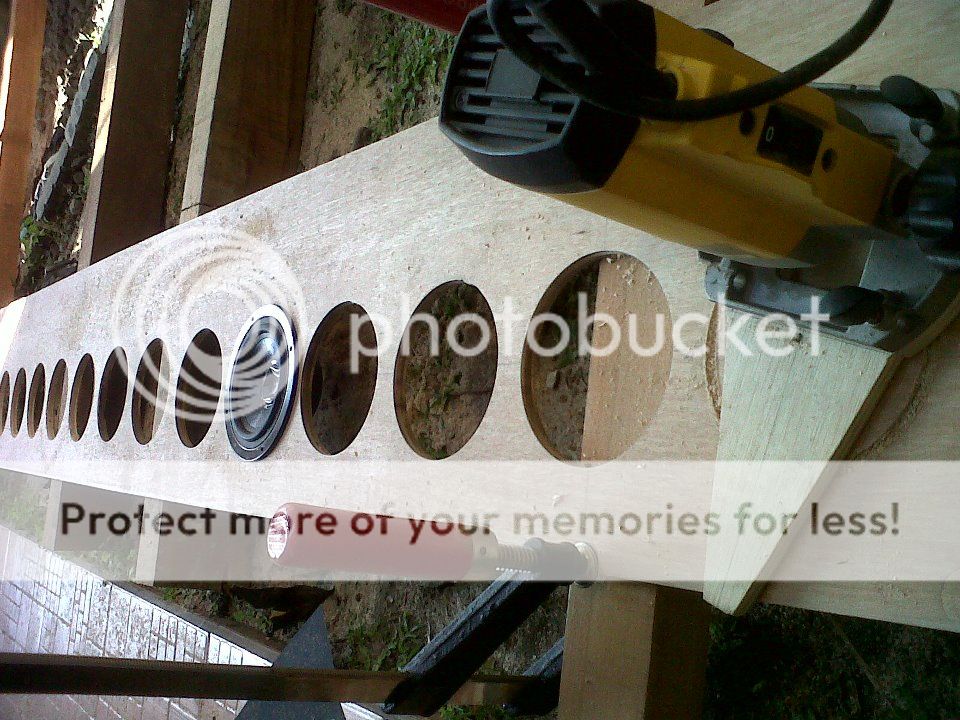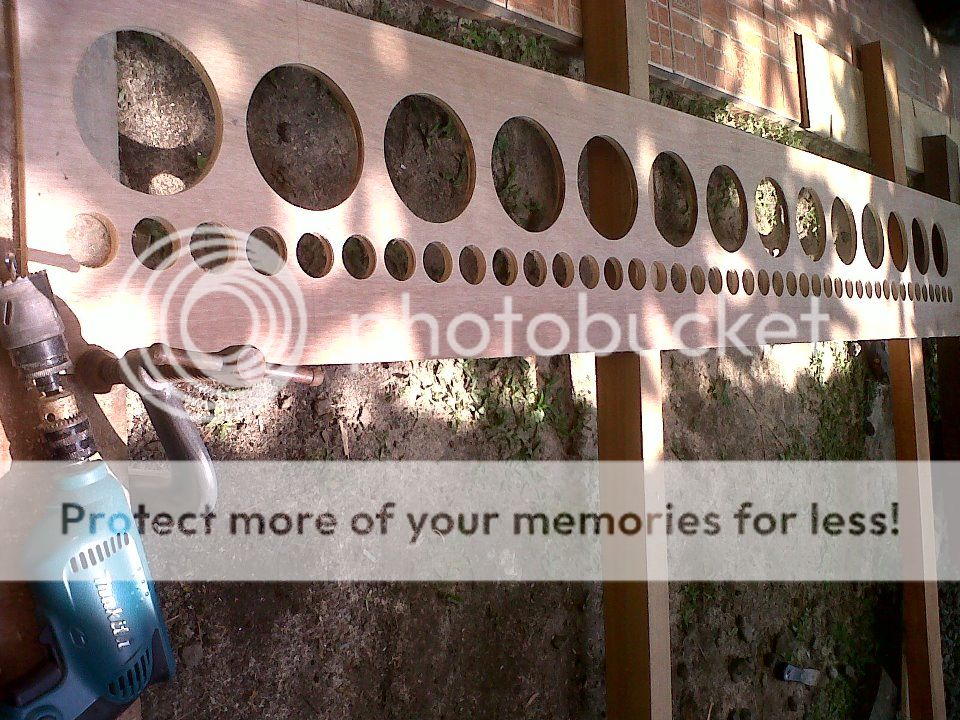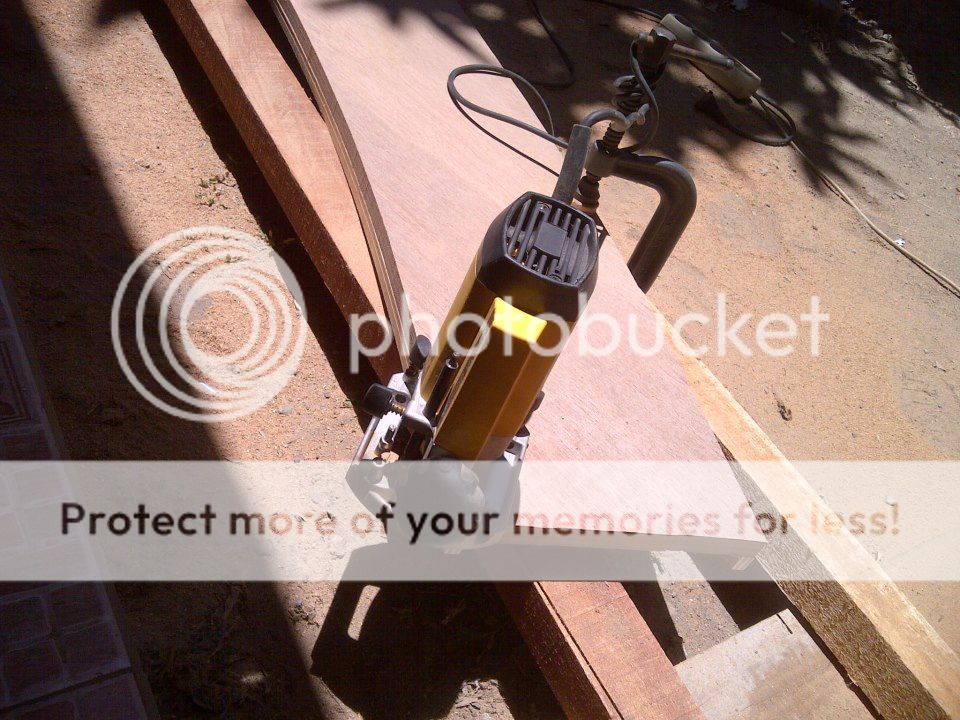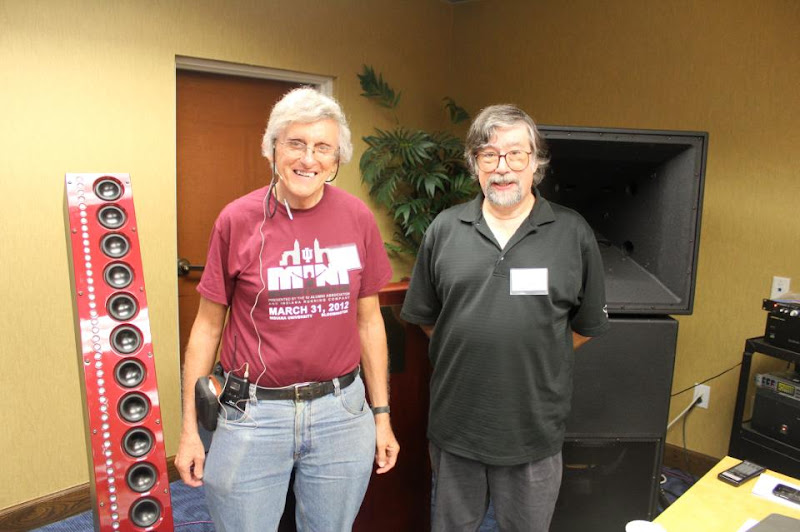Where I heard the CBT the ceiling was fairly high, so not a problem. But the CBT has a narrow vertical spread, doesn't it?
64 % of 36 degrees, which means 23 degrees vertical spread from around 200 Hz to 16 kHz if I remember correctly.
hello
firstly thank you Dr. Don Keele for sharing the invention.
secondly I would like to share my slow evolving progress on the cbt project:



the hardest step so far is cutting arc smoothly. after four failed attempts with free hand jigsaw including numerous curse-words, i managed it with template and router+flush trimming bit.
firstly thank you Dr. Don Keele for sharing the invention.
secondly I would like to share my slow evolving progress on the cbt project:



the hardest step so far is cutting arc smoothly. after four failed attempts with free hand jigsaw including numerous curse-words, i managed it with template and router+flush trimming bit.
Last edited:
hi John
the grating lobes started to occur beyond one wavelength as evidence in dr. Don paper below, page 13-14: http://audioartistry.com/Papers/CBT Paper4 PracticalImplementationCircularArcCBTArrays.pdf
Thanks for the PDF notes. If anyone else read my post and scratched their head, the PDF above has illustrations which make it a lot easier to follow.
Keele's commentary doesn't 'sync up' with his data, or at least not 100%. For instance, I would argue that "ideally" you'd want to limit his tweeter line to 4009hz. (34000 cm per second / 2.1cm ctc distance / 4 ) Keele argues that you can go two octaves higher, to 16khz. On page 14, Keele says "The measured vertical polars of the small-driver array are shown in Figs. 31 – 35 over the range of 200 Hz to 16 kHz. The vertical polars are very consistent and well controlled all the way up to 16 kHz. The array
appears to work well up to the frequency where the spacing is equal to a wavelength. The 21.2 mm (0.835”) center-to-center spacing of the drivers is one wavelength at about 16.2 kHz"
But if you look at the data, specifically Figure 35, you'll see that the answer is somewhere in between. It looks like the directivity widens at somewhere between 12.5 and 16khz. So basically my "ideal" of one-quarter wavelength is a bit too strict, but Keele's ideal of one wavelength is a bit too loose. (IMHO)
Perhaps an upper limit of (34000 / center to center spacing / 1.5) might be a good goal. For Keele's CBT, that works out to 11khz.
This reminds me a lot of modeling horns in Hornresp. The sims tend to exaggerate how bad the high frequency response will be. In the real world, the high frequencies tend to be a lot better behaved than the sims would indicate.
Mixed Acoustical Astigmatism
I have yet to hear a line array loudspeaker that did not sound nasty (unnatural) to my ears. I suspect the reason for this may be explained as follows:
In the transverse (horizontal) plane, the acoustic image of a line array is in the immediate vicinity of the drivers. In the longitudinal (vertical) plane it is far removed behind the driver array. While delay shaping of the wave front in the longitudinal plane brings this image slightly forward, the anomaly still remains, and it may be characterized as mixed acoustical astigmatism.
Regards,
WHG
I have yet to hear a line array loudspeaker that did not sound nasty (unnatural) to my ears. I suspect the reason for this may be explained as follows:
In the transverse (horizontal) plane, the acoustic image of a line array is in the immediate vicinity of the drivers. In the longitudinal (vertical) plane it is far removed behind the driver array. While delay shaping of the wave front in the longitudinal plane brings this image slightly forward, the anomaly still remains, and it may be characterized as mixed acoustical astigmatism.
Regards,
WHG
Last edited:
I've heard the CBT array. It did not sound like a normal line array. It's surprisingly good and very consistent thru angles and distance.
At what cost?
TD's solution is acoustically superior, less costly, and less prone to failure in the field. But of course, it is not a 'sales vehicle' for a manufacturer who wants to move lots of drivers, amplifiers and boxes as well.
Regards,
WHG
I've heard the CBT array. It did not sound like a normal line array. It's surprisingly good and very consistent thru angles and distance.
TD's solution is acoustically superior, less costly, and less prone to failure in the field. But of course, it is not a 'sales vehicle' for a manufacturer who wants to move lots of drivers, amplifiers and boxes as well.
Regards,
WHG
Last edited:
I've heard both, but not side by side. For stadium work, I'd probably tip my hat to Danley. For home Hi-Fi it's hard to say. Would have to hear them side by side.
FWIW, the CBT I heard was passive, not active. There was an active sub, tho.
FWIW, the CBT I heard was passive, not active. There was an active sub, tho.
Pano,
If you mean the CBT demonstrated at the MWAF in Dayton by Don Keele and Marshall Kay in 2010, then it does have an active crossover. Marshall used a Behringer DCX-2496 three way crossover for the 3-way frequency bands (sub, woofer, and tweeter). The weighting networks for the power adjustments were implemented within the CBT towers (4 weights per each woofer and tweeter line) as passive resistor networks. Essentially, the implementation is the same as for the Parts Express CBT kit as currently sold.
If you mean the CBT demonstrated at the MWAF in Dayton by Don Keele and Marshall Kay in 2010, then it does have an active crossover. Marshall used a Behringer DCX-2496 three way crossover for the 3-way frequency bands (sub, woofer, and tweeter). The weighting networks for the power adjustments were implemented within the CBT towers (4 weights per each woofer and tweeter line) as passive resistor networks. Essentially, the implementation is the same as for the Parts Express CBT kit as currently sold.
Last edited:
Ah, thanks Jim. I knew about the active crossover to the sub, but not to the tweeters.
I do remember the passive shading, as the resistors would get hot and you could smell them. 😀
I do remember the passive shading, as the resistors would get hot and you could smell them. 😀
I heard the CBTs at MWAF and was very impressed. However, I'm one of the many that doesn't have a spare 5ft just to be empty space behind speakers. I need to use speakers close to the wall in any room I'm likely to use in the foreseeable future. So Danley's solution definitely works better for me.
hi BillHowever, I'm one of the many that doesn't have a spare 5ft just to be empty space behind speakers.
any document/theory to support this?
Keele CBT
Direct Access to Keele's CBT AES Papers
Audio Artistry
Regards,
WHG
hi Bill
any document/theory to support this?
Direct Access to Keele's CBT AES Papers
Audio Artistry
Regards,
WHG
thanks WHG.
found a pic from DSL fb, two horn gurus met:

I wish there is a video footage of this event. Pano was there.
found a pic from DSL fb, two horn gurus met:

I wish there is a video footage of this event. Pano was there.
The Synergy is an interesting speaker. I'd heard it once before (briefly) and remained skeptical. Not this time. It really is a point source contained by a pyramid. Tom invited me to stick my head into the horn. I did. The sound seems to originate from a sphere about the size of your fist that is 6-8" forward of the horn apex. No hint of multiple drivers in space. And he does that with a passive crossover.
One of the funniest parts of the day was the PowerPoint slide that Don Keele had made proposing a 22 foot tall CBT made of Danley horns. That's a scary thought! Keele really liked the Synergy, and Danley was proud to be making a presentation in front of the master, Don Keele. Tom told me that when he was starting out Keele was one of the few speaker designers who would give him the time of day, and was a big help in some Danley designs. I forgot to take a camera, but there is a shot (I'll get it) of the two of them standing together beside their creations.
These are both controlled directivity designs, but thru vastly different techniques. Interestingly the tonal balance was similar (and good) on both, but imaging was very different. The Synergy can peg a phantom center image like few speakers I've ever heard. The CBT was more diffuse.
It was the SH-50. Typical medium size hotel meeting room. Horns were at one end, spread wide nearer the side walls than the center. One about 3 feet off the ground, the other about 4 feet. Pointed in maybe 30-40 degrees. In the photo posted below you see the table just to the right of the screen down front. One horn was at its far right corner, the other in the same position on the left side of the room. The CBTs were set up just inside (toward center) of that.
Room is 25 feet wide, 38 feet long (about 7.6x11.5 m) . I was about 25 feet back, centered. See below. If I can get photos of the setup, I'll post.
The SH-50s were used as P.A. All of the conference speakers used a wireless mic, some hand-held, some lavaliere, one headset. That was funny for me because it's what I do for a living, meetings. So every day I heard some guy or gal on a wireless talking and showing slides. It was a perfect reference for me. The SH-50 were astonishingly clean and clear, put the voice right in the center about 6 feet high and never had feedback. Don Keele stood right in front of one horn for most of his talk, his back almost touching it. It never squealed, not even close.
Both the CBT and the Synergy did exactly what the designers said they would do, as far as I could tell. Remember, Keele and Danley are engineers, not marketers, so their claims were technical and accurate. No spin, no BS, no fancy wires. 🙂
No, no real critical listening or A/B tests on the same tracks, which is why I hesitate to give these a "review." But I did hear them in the same space not more than an hour apart, so it was informative - for me at least. Both work well, both sound much bigger than they look. The CBT is more "matte" sounding, for lack of a better term. A little cleaner, but less energy, in the bass than the Synergy horn.
The SH-50 will play insanely loud with no hint of strain. Mostly it was played too loud for the music type, I.E. louder than similar acoustic music would have been in the room. But it had no trouble doing so. Dynamic like crazy. The CBT is much less efficient and could not play as loud (as Keele pointed out) but could do very well, I think, in a normal sized living room/lounge.
Neither had the charm or warmth of my Altec rig, nor the musicality or smoothness. But they were not optimized to the room and were using typical pro electronics, not noted for warm or smoothness. Would love to hear the SH-50 on and SET amp. I'll keep bugging Tom about it.
I'm one of the many that doesn't have a spare 5ft just to be empty space behind speakers. I need to use speakers close to the wall in any room I'm likely to use in the foreseeable future.
I recently saw a line array that was intended to be set into a corner, and used the corners as reflecting / broadening agents, much as Dr. Keele's array uses the floor to "mirror" the array.
Just wondering if anyone who owns a CBT array has experience with them in the corners. What was their experience "without the air"?
Ron
I have yet to hear a line array loudspeaker that did not sound nasty (unnatural) to my ears. I suspect the reason for this may be explained as follows:
In the transverse (horizontal) plane, the acoustic image of a line array is in the immediate vicinity of the drivers. In the longitudinal (vertical) plane it is far removed behind the driver array. While delay shaping of the wave front in the longitudinal plane brings this image slightly forward, the anomaly still remains, and it may be characterized as mixed acoustical astigmatism.
Regards,
WHG
Hi WHG,
i am not quite shure whether i correctly understood your review on how "conventional" line arrays can sound in an acoustical small room.
Nevertheless i have some experience in listening to line array concepts of my own design
Dipol 08 open baffle line array, Strahlerzeile mit offener Schallwand
- those also having fairly narrow vertical dispersion (but rather balanced energy response) -
vs. loudspeakers that have a wider and more diffused dispersion especially in the vertical plane.
Been a line array (narrow vertical dispersion) advocate for many years, i see that kind of dispersion pattern more critically by now when used in an acoustical small room at home, especially if side walls are not heavily furnitured.
A more or less cylindrical shaped wavefront reflected from the side walls will make up for strong and highly correlated (to the direct sound) early reflections from the side walls.
As long as those reflections are delayed sufficiently, they will not harm localization too much, but there will be IMO - among other peculiarities - an increase in perceived loudness especially with percussive programme.
Listening to a system causing more diffuse side reflections - also placing diffusers at the side walls will pull the impression in the same direction - there will be a more balanced loudness impression e.g. when comparing strings and vocals to percussive sounds like those from bongos, congas etc.
That (too ...) highly correlated energy from side reflections might also tend to "flatten" the image in depth (dependent on the recorded material of course), which may be due to that imbalanced loudness impression too, i am not quite shure about that. Also the range in "enjoyful" listening levels - due to recorded programme - may tend to shrink by this mentioned effect, even though line arrays provide a high directivity, which is usually advantageous when listening at higher levels in a reflective environment.
In the last years i do not feel anymore, that line arrays are advantageous in the acoustic small room (usual living room), unless one carefully uses diffusers (and/or suitable furniture) to sufficently decorrelate the side reflections from the direct sound. There also has to be a sufficient delay in those reflections, which IMO is true for nearly any kind of loudspeaker.
Especially at larger venues - which provide larger delay of reflections to the audience and also might provide more diffusivity - line array concepts and also CBT array concepts are very good at covering the audience in a balanced manner.
That's where i see their main advantages now ...
Last edited:
In the last years i do not feel anymore, that line arrays are advantageous in the acoustic small room (usual living room), unless one carefully uses diffusers (and/or suitable furniture) to sufficently decorrelate the side reflections from the direct sound. There also has to be a sufficient delay in those reflections, which IMO is true for nearly any kind of loudspeaker.
LineArray
Quite a turn around. Welcome aboard!
May 10, 2016 Don and Kevin Keele have released "The CBT Chronicles" on 'The Official D.B. Keele, Jr. Youtube page'. The CBT Chronicles are a nine-part video series by inventor Don Keele covering the history and technology of CBT (Constant Beamwidth Transducer) loudspeaker arrays including detailed comparative measurements of a traditional speaker system and a CBT array. You can access the playlist at: http://tinyurl.com/CBTChronicles (redirecting to Youtube)
For further information contact Don Keele at DKeeleJr@Comcast.net
For further information contact Don Keele at DKeeleJr@Comcast.net
In another forum, I posted this idea that some CBT builders might find interesting.
Basically, there seems to be an easy way to simplify the CBT, by simply using log shading.
Here's what I posted:
Dave Smith has done a lot of work on arrays. He posts here as "speakerdave." Mr Smith has worked on arrays from Snell and McIntosh, and worked on projects at JBL. I believe he worked alongside with the CBT inventor (Keele) at JBL.
Mr Smith has posted good results when using 'log shaded arrays.'
Log shaded arrays and CBT arrays are not the same thing, but it's occurred to me that it should be possible to combine them.
Here's how this works. This is a 'laymans interpretation', so Mr Smith or Mr Keele might correct me here.
Having said that, here goes:
In a CBT array, we are improving the off-axis response by manipulating the amplitude and the phase of the array. You can manipulate the amplitude by lowering the voltage passively, using resistors. Or you can manipulate the amplitude by using dedicated amplifier channels. We are manipulating the phase of the array by curving the array. You could accomplish the same thing via DSP delay, or even passive delay. The patentholder of the CBT technology does both, depending on the model. (IE, they have some CBT arrays that are physically flat but electronically curved.
OK, I hope that made sense. I've posted about CBTs over the years, and the concepts described above are related in greater depth in some of my older posts.
Now let's talk log shading.
As I understand it, log shading reduces the amplitude of the array at the edges. The exact same thing that a CBT array does, and many other shaded arrays. The 'neat' thing about the log shaded array is that the shading is accomplished by simply eliminating elements in the array. For instance, if you had a sixteen element straight array, you could 'shade' the array using resistors. Log shading 'shades' the same array by simply omitting elements. IE, if you want half as much power going to the edges of your array, instead of reducing the voltage to the edges by half, you can simply omit half of the drivers at the edge of a log shaded array.
That paragraph above is a simplification of how log-shading works. For all the detail, you can get the math in the patents. But IMHO, the idea is the same. If you want to shade an array, you can simply eliminate elements of the array. This has quite a few advantages, particularly in consumer audio:
1) It requires fewer drivers
2) For a given number of drivers, you can get directivity control lower. For instance, if you have eight drivers and a center-to-center spacing of 5cm, your line array will have directivity control down to 850Hz. If you use log shading, and you stretch the length of the array by 50%, you'll be able to control directivity down to 567Hz with the same number of drivers. (40cm array vs 60cm array)
3) Assuming that you're using the same voltage to every element in the array, you don't have a 'single point of failure.' In a CBT array, the drivers at the edge of the array are receiving a tiny fraction of the voltage going to the center. Due to this, the elements in the center of the array are 'the weakest link' in the chain.
4) resistor arrays are expensive and bulky. Log shaded arrays don't need them.
Basically, there seems to be an easy way to simplify the CBT, by simply using log shading.
Here's what I posted:
Dave Smith has done a lot of work on arrays. He posts here as "speakerdave." Mr Smith has worked on arrays from Snell and McIntosh, and worked on projects at JBL. I believe he worked alongside with the CBT inventor (Keele) at JBL.
Mr Smith has posted good results when using 'log shaded arrays.'
Log shaded arrays and CBT arrays are not the same thing, but it's occurred to me that it should be possible to combine them.
Here's how this works. This is a 'laymans interpretation', so Mr Smith or Mr Keele might correct me here.
Having said that, here goes:
In a CBT array, we are improving the off-axis response by manipulating the amplitude and the phase of the array. You can manipulate the amplitude by lowering the voltage passively, using resistors. Or you can manipulate the amplitude by using dedicated amplifier channels. We are manipulating the phase of the array by curving the array. You could accomplish the same thing via DSP delay, or even passive delay. The patentholder of the CBT technology does both, depending on the model. (IE, they have some CBT arrays that are physically flat but electronically curved.
OK, I hope that made sense. I've posted about CBTs over the years, and the concepts described above are related in greater depth in some of my older posts.
Now let's talk log shading.
As I understand it, log shading reduces the amplitude of the array at the edges. The exact same thing that a CBT array does, and many other shaded arrays. The 'neat' thing about the log shaded array is that the shading is accomplished by simply eliminating elements in the array. For instance, if you had a sixteen element straight array, you could 'shade' the array using resistors. Log shading 'shades' the same array by simply omitting elements. IE, if you want half as much power going to the edges of your array, instead of reducing the voltage to the edges by half, you can simply omit half of the drivers at the edge of a log shaded array.
That paragraph above is a simplification of how log-shading works. For all the detail, you can get the math in the patents. But IMHO, the idea is the same. If you want to shade an array, you can simply eliminate elements of the array. This has quite a few advantages, particularly in consumer audio:
1) It requires fewer drivers
2) For a given number of drivers, you can get directivity control lower. For instance, if you have eight drivers and a center-to-center spacing of 5cm, your line array will have directivity control down to 850Hz. If you use log shading, and you stretch the length of the array by 50%, you'll be able to control directivity down to 567Hz with the same number of drivers. (40cm array vs 60cm array)
3) Assuming that you're using the same voltage to every element in the array, you don't have a 'single point of failure.' In a CBT array, the drivers at the edge of the array are receiving a tiny fraction of the voltage going to the center. Due to this, the elements in the center of the array are 'the weakest link' in the chain.
4) resistor arrays are expensive and bulky. Log shaded arrays don't need them.
- Home
- Loudspeakers
- Multi-Way
- Constant Beam Width Transducers line arrays